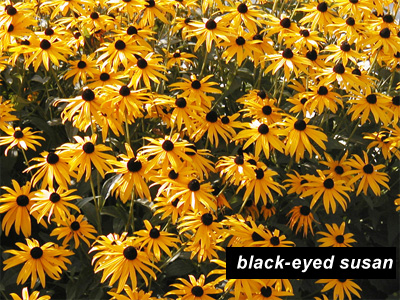A Little Planning Now can Make Planting Your Garden a Lot Easier Later
Last Updated:
Just like any large task, planting the gardens around your home looks daunting at first. But taken a step and an hour or two at a time, you'll be surprised how much you can accomplish towards your gardening goals for the season.
Take the Time to Determine What to Plant:
Is your garden mainly in the sun or shade? Is your garden in dry sandy soil or wet clay soil? Once you're armed with that information, it makes your decisions much easier because it is critical to choose plants for the right sun and moisture conditions. If you choose native New England plants, you have some leeway with regards to soil and light conditions, so its always best to go with native species if they are available.
Plants for the Dry & Sunny Garden
Plants like coreopsis, echinacea (yes, its the same stuff they make the cold remedy from) and day lilies will do well in sunny, well-drained soil with little attention throughout the season- so will beach roses (rosa rugosa), grasses and pine trees/bushes. All of these plants are pretty much bullet-proof, and they will withstand (and even thrive) with neglect. These are the plants for you if have a brown thumb.
A favorite New England native flower that thrives in these conditions is the black-eyed susan, often seen blooming on northern New England roadways in June-August. This native is also a perennial, bringing quality blooms to the garden for many years while spreading seeds for new plants.

Plants for the Wet & Partial Sun/Shade Area Garden
These gardens are much easier in some respects because more types of plants will grow under these more moderate conditions. Also, the plants you tend to buy at the big box garden centers are those that do require a decent amount of water, fertilizer and sunlight to grow properly.
Again, day lilies are a good choice, because they grow well under almost any conditions, and their clumps grow bigger each year with more flowers. They will bloom even in shady areas, just not as much as if they were in full sun. In the shade, there are a couple of very good choices, one being the hosta and the other being impatiens. Both can survive happily in complete shade all summer and both reward you with great flowers during the season. All they require is a cool moist soil with occasional watering. Planting the hostas in the back allow the tall-spiked flowers which reach 18-24 inches to provide the backdrop for the smaller impatiens plants and flowers in front. In more sunny areas with good dark soils and adequate moisture, vegetables will do their best as they generally require the most sun, water and fertilizer to grow and produce well.
Getting Some Ideas? Hopefully, we've peaked your interest and you've started a little planning on your own. A simple list of plants and their placement in the garden goes a long way to helping your shopping at the garden center in the coming weeks, much like a grocery list. So look for the best deals on the varieties that you need, and pick them up as you go along. Who says the garden has to be planted in a single day, anyway??